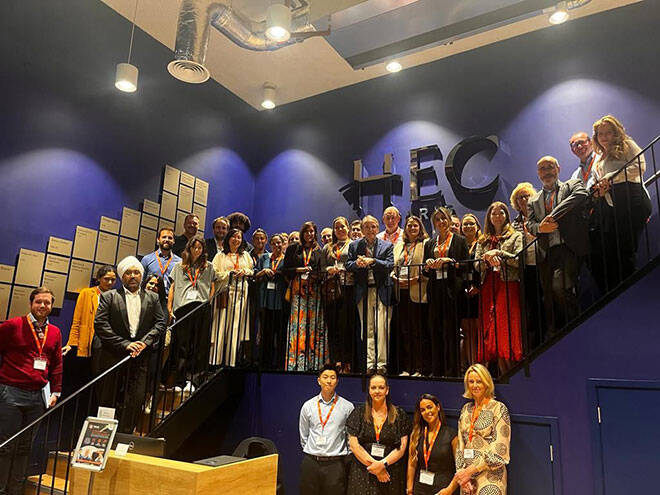How to Encourage an Entrepreneurial Mindset for Leadership within Your Organization
The Entrepreneurial Mindset for leadership is not just a buzzword. It is a fundamental shift in how we approach managing people and innovation in today's fast-paced and ever-changing business environment. By nurturing this mindset in leaders and creating a culture that encourages it, organizations can adapt, innovate, and thrive in an increasingly complex world. But how can organizations truly boost an Entrepreneurial Mindset for Leadership? HEC Paris Professor Shaheena Janjuha-Jivraj addressed this very question during an interactive session at the latest iVentiv event.

Held at the HEC UK House in London, the event was an opportunity for the learning and development community to explore the topic and brainstorm ways to encourage creativity and innovation.
According to Shaheena, navigating a dynamic and complex environment demands a fresh approach to leadership: an Entrepreneurial Mindset for Leadership (EML). Professor Janjuha-Jivraj has dedicated the last 13 years to understanding and promoting innovation and diversity within organizations.
During the workshop, she presented the concept of an entrepreneurial mindset as a dynamic process characterized by vision, change, and creativity:
“An entrepreneurial mindset is about recognizing opportunities where others might see chaos, contradictions, and confusion.”
But what exactly is this Entrepreneurial Mindset for Leadership, why does it matter so much today, and how can you implement it within organizations?
Defining the Entrepreneurial Mindset for Leadership
The entrepreneurial mindset is a way of thinking, doing, and feeling that aligns with entrepreneurial behavior. It involves not just reacting to change but actively seeking and creating opportunities for change. “We know now that creativity is a skill, a muscle that can be nurtured, stimulated, and developed, and the more we develop it the more creative we get, at an individual level but also an organizational level,” Professor Janjuha-Jivraj explained.
Aligning the Thinking, Doing, and Feeling behind the EML
The Entrepreneurial Mindset for Leadership is not limited to entrepreneurs only. It is a mindset that can be cultivated within an organization, no matter its structure.
“When it comes to leadership, the thing that we emphasize the most is the thinking space, and as we focus on the thinking, we need to recognize that the doing is critical, and the feeling is usually the one that is a bit uncomfortable to think about or to consider.”
And to fully understand this concept, Shaheena breaks it down into three components.
Thinking: This element revolves around problem-solving and the ability to think critically. It's about asking questions, challenging assumptions, and fostering mental agility. Thinking in an entrepreneurial way means having a vision that identifies opportunities and solutions amidst complexity. For Shaheena, leaders must reflect on their thinking (or thought) processes, consider how they make decisions, and understand the importance of mental agility, particularly when moving from supervisory to leadership roles.
Doing: The doing component is all about taking action. It involves being a doer, someone who is not afraid of taking risks and experimenting. It also includes recognizing the importance of failing fast and learning from those failures. An entrepreneurial leader encourages innovation through action.
Feeling: Feeling, in this context, refers to acknowledging emotions, embracing vulnerability, and fostering authentic leadership. It means understanding and managing your feelings and the feelings of those around you as you navigate change and uncertainty.
Why an Entrepreneurial Mindset Matters
It certainly matters. It is more critical than ever before, especially in our current landscape. It is key to any organization and can make a significant difference. First, in terms of adaptation. An entrepreneurial mindset equips leaders with the ability to adapt quickly to change, seize opportunities, and navigate uncertainty effectively. When it comes to innovation, this approach fosters a culture of innovation, where creative solutions emerge, and the organization remains agile and responsive to market demands. It is also fundamental for employee engagement: encouraging an entrepreneurial mindset can lead to higher employee engagement, satisfaction, and retention as employees feel their ideas are valued and embraced. Additionally, such a mindset has an impact on sustainability: in a rapidly evolving world, organizations that embrace entrepreneurial thinking are more likely to be sustainable in the long run. Finally, on the Diversity and Inclusion spectrum, EML allows organizations to leverage diversity fully, harnessing the power of different perspectives and experiences.
Focusing on diversity to foster creativity and innovation
“There is a lot of talking about diversity today,” stated Shaheena. Organizations are increasingly focusing on recruiting diverse talent, but mostly in terms of gender or ethnicity. Professor Janjuha-Jivraj advises leaders “to go beyond the demographics and talk about cognitive diversity as it helps to get to the heart of helping individuals by doing so.” Indeed, fostering cognitive diversity, and recognizing its value through inclusive leadership and belonging, can lead to the creation of innovative products and services for the market. It also encourages creativity, challenges assumptions, and creates an environment that embraces risk-taking. Ultimately, Shaheena recommends organizations recognize the importance of shifting the model of leadership to accommodate diversity to its fullest.
Encouraging an Entrepreneurial Mindset in Practice
This is the real challenge for leaders. To infuse an EML within an organization and create a space where innovation can flourish, Shaheena discussed the importance of empowering leaders to think differently, take action, and understand their feelings in the context of leadership. She insisted once again on the role of feeling: acknowledging feelings plays a crucial part as emotions often get overlooked in traditional leadership models though they play a significant role in the context of change and innovation. “Being able to articulate emotions, handle uncertainty, and understand risk-taking is an essential aspect of embracing an entrepreneurial mindset,” she affirmed.
The importance of collective intelligence
Collective intelligence remains a key driver in addressing challenges and innovation. Shaheena highlighted the value of the journey in innovation, emphasizing the need to create opportunities for people to exchange ideas, trust each other, and feel safe enough to express their creativity. To foster divergent thinking, organizations should have a shared understanding of innovation and creativity to align their efforts effectively, which tends to be determinant in supporting the diversity, equity, and inclusion (DEI) agenda.
Finally, she advises managers and leaders to shift towards a more open, learning-oriented environment. Recognizing the value of praising efforts, and embracing vulnerability and open dialogue are essential to encourage creativity and innovation within organizations.
Concluding the session, Shaheena mentioned the need to move from thought leadership to "drip leadership," which revolves around educating and preparing individuals who will transition into leadership roles. The whole EML approach, developed by Professor Janjuha-Jivraj, brings light to a new way of developing the skills necessary for nurturing creativity and diversity in the workplace.
What about your organization? If you wish for your leadership teams to develop an Entrepreneurial Mindset for Leadership, and to foster innovation and creativity within your organization, why not co-design a customized program with HEC Paris? Find out how we can deliver a program tailored to your specific needs.
